Seven to Nine Years Old
This page lists books to read to children or for them to read to themselves. For books about children and childraising, see Education.
Many books listed on the pages for earlier ages continue to be suitable for this age, and may be appreciated with a growing sophistication.
Some of these books continue to be suitable for reading at one sitting, but most are longer books that should be read in installments.
Books
- Abel's Island. One summer day, newlywed mice Abel and Amanda are out for a picnic in the woods when they are caught in a sudden storm--a "full-fledged, screaming hurricane" to be precise. As they take refuge in a cave, a wind scoops up Amanda's scarf, and Abel foolishly lunges from safety to retrieve it. So begins William Steig's Newbery Honor Book Abel's Island, the ensuing adventures of this rather foppish mouse as he comes head to head with nature. Amazingly, Abel is swept up in a stream, then a river, then eventually marooned on an island (about 12,000 tails long). He is sure that his rescue is imminent: "It's certainly gotten around that Abelard Hassam di Chirico Flint, of the Mossville Flints, is missing," the society mouse speculates. But he is not so lucky. What will this intelligent, imaginative rodent do to get off the island and back to his beloved Amanda? He busies himself with finding ways to get to shore (including bridges, boats, catapults, stepping stones, and gliders); figuring out what he should eat (everything from mulberries to roasted seeds); and investigating where he should take shelter (in a rotten log). As the weeks and months go by, he misses his books, his paintings, his comfortable stuffed chair, his stylish clothes (now damp, torn, and lumpy), but above all his precious wife Amanda, whom he thinks about constantly. As the mouse faces his new life Robinson Crusoe-style, Abel discovers what it's like to be in tune with the natural world as well as his true nature, and what it's like to return, fortified, to his real home and to the arms of the one he loves. Along the way, readers can't help but rediscover the joys of being alive. (Amazon)
- Chronicles of Narnia by . Exciting, magical adventures begin when Digory and Polly are tricked by Digory's Uncle Andrew into transporting themselves to another world, a world with much at stake, in which the children are confronted by adventurous battles between good and evil.
- D'Aulaires' Book of Greek Myths by . The Greek myths told for young readers. The illustrations and stories convey much of the original, pagan flavor, values and detail.
- From the Mixed-up Files of Mrs. Basil E. Frankweiler by . When Claudia decided to run away, she planned very carefully. She would be gone just long enough to teach her parents a lesson in Claudia appreciation. And she would go in comfort -- she would live at the Metropolitan Museum of Art. She saved her money, and she invited her brother Jamie to go, mostly because he was a miser and would have money. Claudia was a good organizer and Jamie had some ideas too; so the two took up residence at the museum right on schedule. But once the fun of settling in was over, Claudia had two unexpected problems: She felt just the same and she wanted to feel different; and she found a statue at the Museum so beautiful she could not go home until she discovered its maker, a question that baffled the experts, too. (Publisher's summary)
- Spirit of Endurance, The True Story of the Shackelton Expedition to the Antarctic by . In August, 1914, only three years after Roald Amundsen reached the South Pole, Ernest Shackelton led a crew of men to Antarctica to attempt the first-ever trek across the continent. Instead, they became trapped in pack ice and so began a most remarkable journey in which courage, perseverence and rationality -- especially by their leader, Shackelton -- enabled the 27-man crew to rescue themselves through a two-year journey across ice and open, arctic seas.
- Swallows and Amazons. Several children, while on school holiday, are permitted by their parents to use a small sailboat to explore the lake they are staying at. Here, they discover and colonize an island, but discover that there are other chldren also sailing the waters, children who are as inventive as themselves. Told with great detail and from a child's point of view, thes stories convey a sense of boundless., realistic adventure.
- The Book of Three by . A young, immature assistant pig-keeper, with wild dreams of heroic battles, is suddenly thrust into an epic conflict where the responsibility for saving his country falls on him.
- The Indian in the Cupboard by . Nine-year-old Omri discovers that an old cupboard has the power to bring to life plastic figures of an indian brave and a cowboy, or – more exactly – to wrench from their lives in the past a real indian and cowboy and place them in reduced size into Omri's world. Omri and the now-small adults each profit from their adventures.
- The Little House Series, (9-Book Boxed Set) by . These fascinating stories recount the life of Laura, Mary, baby Carrie, Ma and Pa from the late 1870s in a log house in Wisconsin, to a sod house on the Kansas prairie and on as they grew up. They are readable by a young though not beginning reader. Children from about four on can enjoy having these read to them, though only the first three books are suitable for the youngest listeners.
- The Secret School by . A young girl works to complete her grammar-school education. When the local school board shuts down the public school, she and a friend take matters into their own hands, continuing the school in private.
- The Tales of Grandpa Cat by . Three cat children visit their grandpa at the retirement home, expecting to be bored, but instead discover the adventurous histories of the residents and come to a new appreciation of their grandparents. (out-of-print, see sources.)
- The Trumpet of the Swan by . A boy and a young trumpeter swan, born mute, become friends. Through courage and enterprise, the swan triumphs over his obstacle while the boy becomes a young man.
- The Wheel on the School by . When Lina wonders why storks nest in neighboring towns but never in Shora, she writes an essay about storks for her school class. The teacher encourages the children to find out why storks do not live in Shora and to do something to change this, setting into motion a series of adventures and discoveries, beginning with Lina, then her classmates and finally spreading to the whole town.
- Thimble Summer by . Garnet's summer is full of adventures, from the finding of a beautiful, silver thimble in a creek near her family farm, to accidentally becoming locked-in at a library, to showing her pig at the county fair. The stories glow with a sense of growing up in a loving, respectful family.
- 101 Ways to Bug Your Parents by Lee Wardlaw. Sneeze's parents sign him up for a creative writing class. He would rather be at the Invention Convention. Then he comes up with a really good idea...
- A Child's Treasury of Poems by . An excellent selection of poems for children beginning to think conceptually about the world, from mideaval times up to the work of Browning, Tennyson, Wordsworth, Stevenson, Dickinson, Rosetti and Kipling.
- A Wrinkle in Time by . Everyone in town thinks Meg is volatile and dull-witted and that her younger brother Charles Wallace is dumb. People are also saying that their father has run off and left their brilliant scientist mother. Spurred on by these rumors, Meg and Charles Wallace, along with their new friend Calvin, embark on a perilous quest through space to find their father. In doing so they must travel behind the shadow of an evil power that is darkening the cosmos, one planet at a time. Young people who have trouble finding their place in the world will connect with the "misfit" characters in this provocative story. This is no superhero tale, nor is it science fiction, although it shares elements of both. The travelers must rely on their individual and collective strengths, delving deep into their characters to find answers. A classic since 1962, Madeleine L'Engle's A Wrinkle in Time is sophisticated in concept yet warm in tone, with mystery and love coursing through its pages. Meg's shattering yet ultimately freeing discovery that her father is not omnipotent provides a satisfying coming-of-age element. Readers will feel a sense of power as they travel with these three children, challenging concepts of time, space, and the power of good over evil. (Amazon)
- Chitty Chitty Bang Bang by . Caracatus Potts, inventor, his wife and two children save an old race car from scrapping and restore it. During the rebuilding process, it attains some remarkable properties, which the family discovers as a drive to the beach becomes an arial adventure, escape from near marooning on a sandbar in the English channel and then discovery of a mysterious cave in the cliffs of Calais. The children, Jeremy and Jemima, are captured by a desperate gang of robbers but, by cleverness and bravery, foil the gangsters' plans and and are justly rewarded.
- Dealing With Dragons by . Cimorene does not like being a princess, a job that consists mainly in behaving demurely and waiting for marriage. Instead, she moves out of the castle and into a dragon's cave, occupied of course. She is energetic and willing to work, so a dragon hires her to manage the house. When Cimorene discovers a conspiracy against her dragon, she bravely discovers and then defeats the conspirators.
- Ella Enchanted by . Eleanor was given, at birth, what a thoughtless Fairy considered a gift: Eleanor is compelled to be always obedient. Abused and exploited by her stepsisters and stepmother, Eleanor fights to overcome the spell and assert her own choice of who she is, what she will do with her life and whom she will marry, in this case, Prince Charmont.
- Emilie's Runaway Imagination by . Emily loves books, and dreams of having a real library in her farming town. Through imagination and perseverance, she achieves her goal.
- Freckles by . A homeless waif finds his deliverance in the primeval Limberlost swamp. Maimed and abandoned as an infant, Freckles seeks a chance to prove his worth. He is given that opportunity as the guard of the precious timber of the Limberlost. In his stewardship of the woods, he finds happiness in the companionship of the birds and other wild creatures and in the love of the beautiful Swamp Angel. This moving story of courage and virtue will warm the hearts of young and old. (Publisher's summary)
- Frightful's Mountain by . This, the third book in the My Side of the Mountain series, follows the falcon, Fightful, after he is released from captivity.
- Helen Keller's Teacher by . This is the true story of Anne Sullivan, who taught Helen Keller how to think, how to become fully human.
- Homer Price by . Rollicking and good-natured adventures of a boy growing up in a small, American town.
- Jenny Archer by . Principle: Focusing the Mind. When Jenny’s teacher assigns her students to write an autobiography, Jenny writes an exciting story involving bank robbers, an opera star, and an evil twin sister. Her teacher is very angry when she reads this fiction, until Jenny explains that she thought it was supposed to be a “story” about her life. This is a great example of how a misunderstanding can happen, and how well it can be handled.
- King of the Wind by . He was named "Sham" for the sun, this golden-red stallion born in the Sultan of Morocco’s stone stables. Upon his heel was a small white spot, the symbol of speed. But on his chest was the symbol of misfortune. Although he was swift as the desert winds, Sham’s pedigree would be scorned all his life by cruel masters and owners. This is the classic story of Sham and his friend, the stable boy Agba. Their adventures take them from the sands of the Sahara to the royal courts of France, and finally to the green pastures and stately homes of England. For Sham was the renowned Godolphin Arabian, whose blood flows through the veins of almost every superior thoroughbred. Sham’s speed - like his story - has become legendary. (Publisher's summary)
- Marvin Redpost: Kidnapped at Birth? by . Principle: Choices have consequences. The King of Shampoon has come to America looking for his lost son. The missing prince, who was kidnapped at birth, matches Marvin’s description – age 9, red hair, blue eyes. Marvin considers whether he wants to be the prince, or keep the life he has.
- Misty of Chincotique. Two children develop a love for a wild pony, work hard to earn the money to buy her, overcome other obstacles along the way and eventually train her to be a prize-winning racer.
- Mr. Popper's Penguins. Mr. Popper greatly loves Antarctic exploration, and follows avidly the latest discoverers. One day, he receives a gift box shipped by Admiral Drake from the Antarctic. Opening it, he finds a family of penguins. He makes them at home, and part of his family, but the food bills, and the ice bills, eventually motivate the penguins to earn their keep.
- Mrs. Frisby and the Rats of NIMH by . Mrs. Frisby, an ordinary mouse, discovers an extraordinary society of rats, and gradually learns the secret of their origin and their plans, with surprising implications for her history and the future of her family.
- My Side of the Mountain by . Sam Gribley, 12-years-old and strongly disliking living in New York City, moves to his grandfather's abandoned farm in the Catskill mountains and learns to live off the land, self-sufficiently gathering plants and hunting (and sometimes befriending) animals.
- Pet Bugs, A Kid's Guide to Catching and Keeping Touchable Insects by . Identification and care instructions for twenty-six bugs that make good pets.
- Poppy by . A small mouse learns that thinking for herself and acting on her own judgement spells the difference between death and life.
- Questions Kids Ask, Series by . Each book in this series has dozens of interesting questions and answers, of the sort that fascinate kids (and allow them to challenge their parents!), about the largest, smallest and most amazing aspects of the topics covered. The books do not teach principles, but they do feed the curious young mind. By better use of language, these are better addressed to younger children than the DK series. (out-of-print, see sources.)
- Ramona, (series) by . These stories capture accurately the way a child thinks and feels about the issues important to them: friends, siblings, parents, pets, school and all the challenges these entail.
- Rascal by . Who could resist living for a year with a raccoon who is just about your best friend? In this delightful memoir, Sterling North recalls his year with Rascal--a very mischievous and resourceful raccoon. Sterling, a boy of 11, watches in amazement as this baby raccoon, barely the size of Sterling's hand, instinctively washes everything before eating it. Sterling knows that every night Rascal will sneak into the house by hooking his claws onto the back screen door and head straight for Sterling's bed! Virtually everywhere Sterling goes, Rascal is there, and life is filled with one adventure after another. (Publisher's summary)
- Robin Hood by . A simple but exciting retelling of the classic tale of a man driven to banditry by a rapacious government, Robin Hood creates an independent life for himself and a band of similar lovers of life.
- Sarah, Plain and Tall. A widowed father brings Sarah from Maine to the midwest on a trial basis to see if she will become his wife and the two children's mother. Life on a farm is tough, and she misses Maine fiercely, but her growing love for her new family wins her in the end.
- Shiloh by . When 11-year-old Marty Preston chances upon a mistreated beagle pup in his hometown of Friendly, West Virginia, he is not prepared for the ethical questions he has to face. Should he return the dog to its owner, only to have the animal abused again? Should he tell his parents? Should he steal food to help the poor creature? Marty's efforts to cope with these questions provides the moral backbone for this story, which is presented in a language and manner that will be understood by third- and fourth-grade readers. The heart and beauty of this 1992 Newbery Medal winner lies in lessons children will take away with them. (Amazon)
- Tales from the Odyssey by . Odysseus battles giants, sorceresses, monsters and many other challenges in his twenty-year journey from the Troy back to his beloved home, wife and child.
- Tales of A Fourth Grade Nothing by . Principle: Thinking for Oneself. Peter is always relied on by his family to help handle his mischievous little brother, Fudge, whose exploits are told with great humor. Peter has moments of jealousy when his brother gets lots of attention and moments of anger when his brother gets into his things, but manages to handle these feelings well.
- The Borrowers by . The "borrowers" a very small people who live in the small spaces inside the homes of "human beans." They forage many of their supplies from household items. (When you are missing something small, a borrower may be the cause.) Borrowers normally stay hidden, but the oldest daughter of the Clock family, Arrietty, is more bold, and begins relationships with Big People, leading to complications.
- The Castle in the Attic by . William finds that a toy castle is actually magic. Through an error of judgement, William uses the magic to shrink his beloved housekeeper, Mrs. Phillips, to the size of a toy character. Realizing his mistake, William shrinks himself so that he can go on a quest to defeat an evil wizard and restore himself and Mrs. Phillips.
- The Door in the Wall by . "If thou followeth a wall far enough, there must be a door in it." While his parents are away in a war, Young Robin's legs become paralyzed, making him unfit for his intention to follow his father's career as a knight. When a plague sweeps England and all the servants flee, Robin moves to a monastary, where he learns purpose, courage, and patience. Later, Welsh invaders beseig a castle he is staying in. Robin makes his way through the enemy lines, brings help, rescues the castle, and is re-united with his parents.
- The Eye and I by Lee Wardlaw. Principle: Self-Confidence. The 5th grade teacher has assigned the students to give a speech on how to do something, and she will use a video camera so that each child can see how well he has done. Jeremy is terrified of appearing before the camera, but gets some advice from a book on how to give a speech. He overcomes his fear to give a successful presentation in class.
- The Great Brain (series) by . Set in the early 1900's in Utah, this is the story of 10-year old Tom, aka The Great Brain, told by his admiring younger brother. The Great Brain is enterprising, always up to a new plan to make money, a boon to his friends and a terror to his enemies. It reflects the positive, American, can-do sense of life, with no elements of political correctness intruding. Example: A commentary on toleration approaches the problem of being bullied from a position of strength, noting that because the narrator and his brother are capable of defending themselves, they enjoy a lot of toleration, observing "It was just a question of us all learning how to fight good enough ... After all, there is nothing as tolerant and understanding as a kid you can whip."
- The King's Equal. A cruel and vain prince becomes king on the death of his wise father, who requires that the new king must marry a woman who is his equal in wealth, beauty and brains. He finds one who is even more than that, but discovers also that winning her requires character he does not possess.
- The Light Beyond the Forest by . The tale of King Arthur and his knights, a story of honor and courage, elegantly told and illustrated.
- The Other Side of the Mountain by . This, the sequel to My Side of the Mountain series, continues Sam's story after he re-encounters civilization.
- The Princess Tales by . In these imaginative recasting of classic fairy tales, the storylines depart from the details of the originals, usually to great improvement, yet always come back to the main line. Familiarity with the classic versions is recommended before reading these.
- The Sword in the Stone by . An old wizard named Merlyn takes care of a curious young boy named Wart and transforms him into Arthur, the future king of Britain, in a beautiful new edition of the classic tale, enhanced by luminous paintings. (Amazon)
- The Tower Treasure by . The Tower Treasure is the first volume in the original The Hardy Boys Mystery Stories. Frank and Joe Hardy think that there is a connection between a car theif and a jewel robbery, of which one of their friends' father stands accused. The boys pursue clues until the find the real theif, recover the jewels, and clear the innocent man's name.
- The Twenty-One Balloons by . Professor William Waterman Sherman sets out to have a relaxing year of sailing aimlessly in a baloon whereever the wind takes him. Instead, he crashes on the supposedly-uninhabited island of Karakatoa, discovers an amazing and urbane civilization and escapes with his new friends just in time to avoid being blown to bits by an enormous volcanic explosion.
- The Wonderful Winter by . Young Sir Robert Wakefield, "Robin" as we come to know him, argues with his stuffy aunts because he wants to keep a lost puppy and his aunts won't let him. So he runs away to London where he falls-in with a troupe of actors, including one William Shakespeare.
- The World of King Arthur and His Court by .
- What Do You Say, Dear? by . Hilarious settings and winsome drawings introduce children to manners.
- Ancient Greece, Sightseer's Guide to the Golden Age of Greece by . Using the format of a travel guide, as though the reader were about to visit Ancient Greece, this travel guide covers the essential sightseeing information: Athens, travelling, what to wear, food and drink, shopping, accomodation, theatre, government, the Acropolis, the Olympic Games, Sparta, the countryside and a souvenir quiz.
- Hans Brinker, or The Silver Skates. Two children, by skill and hard work, win a prize. The story is slowed enormously by long digressions into Dutch history and geography.
- Hurry Home, Candy by . The dog, lost and afraid, works to find friends and a real home. One of the beauties of this story is that it is told convincingly and sympathetically from the dog's point of view.
- Nutcracker by . This vigorous translation of E. T. A Hoffman's story has complexity, poetry and depth missing from other versions. Here we find stories within stories from the mysterious Herr Drosselmeyer, the curse of Madame Mouserinx, what happened to Princess Pirlipata, the origin of the Nutcracker and his enmity with the Mouse King, and how Marie, by her bravery, saved the town, married the prince and became Queen of Marzipan Castle.
- Old Yeller by . At first, Travis couldn't stand the sight of Old Yeller. The stray dog was ugly, and a thieving rascal, too. But he sure was clever, and a smart dog could be a big help on the wild Texas frontier, especially with Papa away on a long cattle drive up to Abilene. Strong and courageous, Old Yeller proved that he could protect Travis's family from any sort of danger. But can Travis do the same for Old Yeller? (Amazon)
- Ragged Dick, or Street Life in New York with the Boot Blacks by . Fourteen-year-old Dick Hunter lives on the streets of New York in the 1860s. His parents are dead, and he has been on his own since the age of seven. He shines shoes to earn a living. He sleeps in boxes. He jokes about having a mansion on Fifth Avenue and about owning shares of Erie Railroad stock. But he cannot imagine ever being more than a bootblack who spends every cent he earns and lives hand-to-mouth--until by chance he meets Frank Whitney. (Publisher's summary)
- The Moffats by . To the Moffat children, every day is full of adventures: a surprise ride on a train, a horse-drawn carriage that takes them far from home, lost-and-recovered money and other episodes that might look small to an adult but, told from a child's point of view, are significant.
- The Railway Children by . An innocent man is falsely accused of a crime. His children work to prove his innocence, and succeed.
- On Beyond Zebra by . A deligntful adventure in the value of not being stuck to the conventional, but viewing the world as an exciting opportunity for discovery. Out of print, withdrawn by the publisher, for unexplained reasons having somethign to do with political sensitivity. (out-of-print, see sources.)
Audio Recordings
- Chronicles of Narnia (audio) by . Exciting, magical adventures begin when Digory and Polly are tricked by Digory's Uncle Andrew into transporting themselves to another world, a world with much at stake, in which the children are confronted by adventurous battles between good and evil.
Videos
- The Parent Trap by . Two girls discover that they are twins, separated in youth, and work to reunite their divorced parents.
- Toy Story by . Woody overcomes his jealosy and Buzz Lightyear his delusions when they realize that the values they hold in common are more important than their rivalry.
- Toy Story 2 by . Woody discovers that a finite life full of values is better than a value-empty immortality.
Text Books and Reference Books
- Singapore Math. Math books and curricula for pre-K through 12th grade. These books are cheerful, fun and teach math from the basics up.
- Websters New World Children's Dictionary. Of all the children's dictionaries I've looked at, this one typically has the most conceptual definitions, that is, definitions naming the essential characteristics of the term defined rather than non-essentials and incidental consequences.
Links
- History at Our House – Historian Scott Powell offers classes by teleconference and recommends books to read.
- Kids Need History Early – You want to include history in your homeschooling curriculum, but you face a lot of tough questions. At the top of the list are what to teach, and how. But if you want to help your child to appreciate history, an equally important question is when to start teaching it. The sooner children start learning the right history, the greater the chance they will learn to love it.
- Music at Our House – Music teacher M. Zachary Johnson teaches children to understand and appreciate the value of music to leading a value-rich life.
- Ohaus Primer Balance – A simple, durable balance for children to learn physics from.
- VanDamme Academy Favorite Books by Grade Level – An excellent list of books for children, grouped by the grade level they are typically appropriate for.
- Why History? – Why should kids study history? Why should anyone, for that matter? Here is why.
Credits
- Contributor: Lisa Van Damme, Teacher
- Contributor: Susan Crawford, Runs the Rational Parenting email discussion group.
copyright © 2024 Andrew Layman, all rights reserved, 1/15/2024 6:08:10 PM, Topic: Seven to Nine, http://www.strongbrains.com
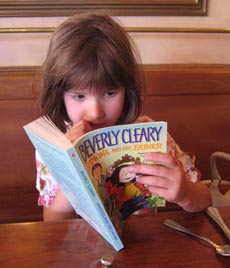
Dagny Reading Ramona and her Father
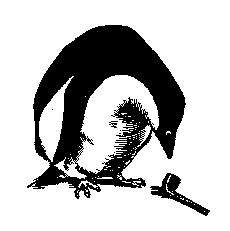
Captain Cook examines Mr. Popper's Pipe, illustration from Mr. Popper's Penguins.
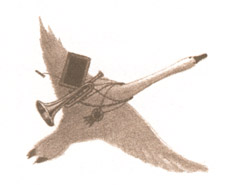
Louis the Trumpeter Swan, from The Trumpet of the Swan
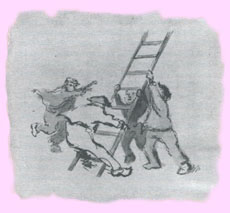
Ladder-Raising scene, from The Wheel on the School
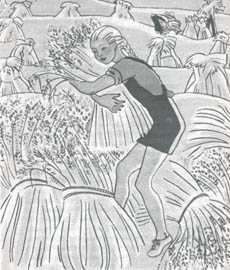
Garnet Harvesting Oats, from Thimble Summer
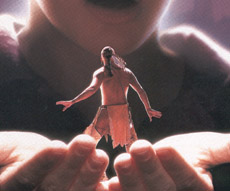
Little Bear and Omri, from The Indian in the Cupboard
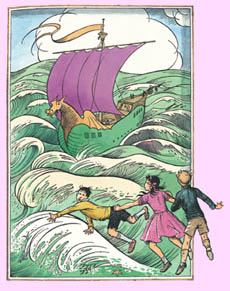
The Dawn Treader from Chronicles of Narnia



